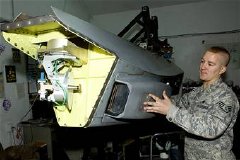Dec 30 2008
High above Iraq, Air National Guard F-16 Fighting Falcons fly over suspected terrorist areas, taking high-resolution images with a sophisticated photographic system contained inside a Theater Airborne Reconnaissance System, or TARS, pod.
 Staff Sgt. George Suonvieri checks out a Theater Airborne Reconnaissance System pod held in place by a giraffe stand
Staff Sgt. George Suonvieri checks out a Theater Airborne Reconnaissance System pod held in place by a giraffe stand
Ground commanders use the imagery from these 332nd Air Expeditionary Wing TARS pods to help them achieve their tactical objectives.
Tucked in a small trailer here, the 332nd Expeditionary Operations Support Squadron TARS team plays a key role in the production of imagery that is critical for ground forces' mission planning, providing battlefield operators with up-to-date imagery of roads, houses, structures, neighborhoods and other areas of interest.
The missions begin with target selections made by officials at the Combined Air Operations Center and other customer units. Next, Staff Sgt. Matt Dallas, an imagery analyst with the 332nd EOSS, starts to plan out the next day's missions.
"I develop maps with targets and route plans the pilots will take to the targets," said Sergeant Dallas, a Williamsburg, Va. native who is deployed from Langley Air Force Base, Va. "If the pilots don't know where to go, they don't get the imagery we need."
After the pilots return from their missions, other specialists download and process the imagery. An Airman sits in front of a set of computer monitors to look at the highly detailed pictures.
"I analyze the imagery based on the needs of the customer," said Senior Airman Katie Boston, a 332nd EOSS imagery analyst. "I look for things like the heights of walls, vegetation, windows and entry points on buildings for raid planning.
"I also do improvised explosive device detection," said the Milwaukee native who is also deployed from Langley AFB. "(I look for) things like disturbed dirt, piles of rocks or any suspicious objects on the side of the road. We keep our customers better informed of the environment. We help them see the area before they even get there, which helps with their planning."
Master Sgt. Stephen Clingerman closely observes the process to ensure his analysts don't miss anything.
"We supply the decision makers with imagery intelligence, so they'll be informed for future operations," said Sergeant Clingerman, an imagery analyst with the 332nd EOSS. "We are here to be a part of making sure the safety and security of Iraq is maintained."
Sergeant Clingerman, a native of Waterloo, N.Y., explains that unlike unmanned aircraft like the MQ-1 Predator, which loiter for long periods over target areas for surveillance but risk discovery, a fast-moving and high-flying F-16 with a TARS pod can capture imagery virtually unnoticed. That difference gives ground commanders a chance not to alert insurgents of possible future tactical operations.
"With TARS-pod imagery, we receive a high-resolution image that warfighters can use for planning," said an intelligence collections manager with the Combined Joint Special Operations Task Force - Arabian Peninsula who has used TARS in previous missions supporting Operation Enduring Freedom. The collections manager's name was withheld for operational security.
Although TARS pod resources do not provide real-time images, the capability provided to ground commanders helps achieve effective tactical planning, the intelligence collections manager said. It also provides flexibility in capturing difficult-to-reach target locations, which could present a critical advantage, depending on the desired objectives.
"As with all intelligence, surveillance and reconnaissance, it's another low-density, high-demand asset, enhancing the warfighters battlespace awareness," the intelligence collections manager said.
According to Sergeant Clingerman, without the TARS pod imagery and his analysts doing their jobs, an important piece of the intelligence surveillance and reconnaissance would be missing.